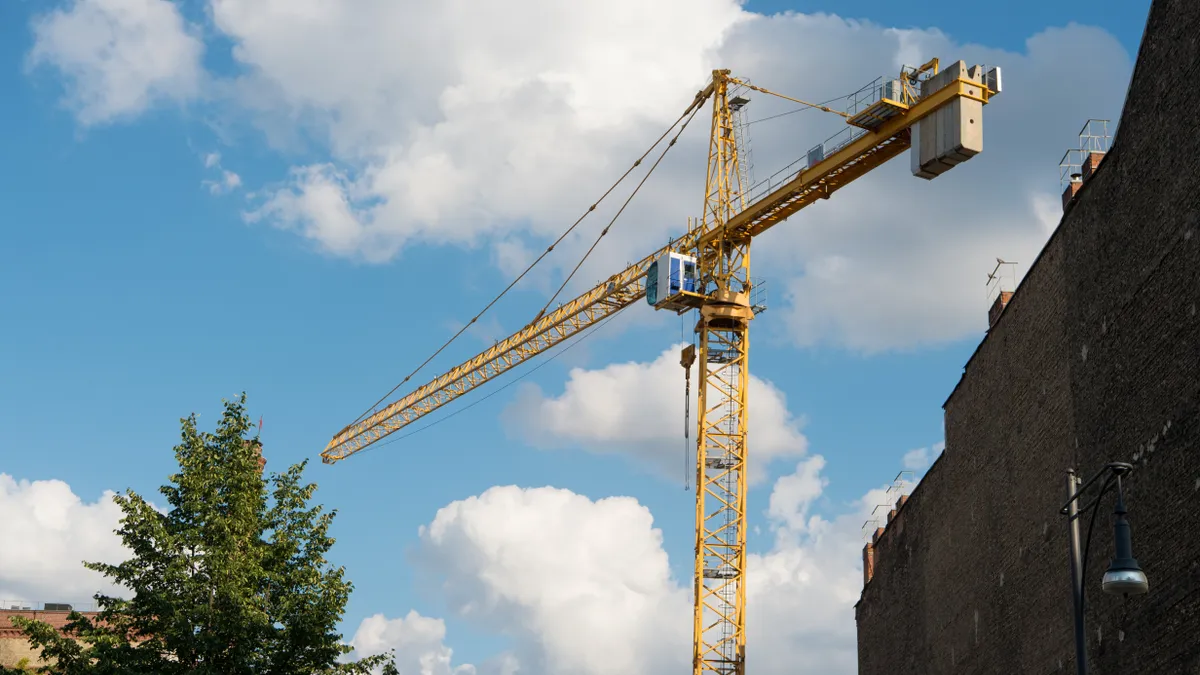Spending on buildings remains healthy, yet Kermit Baker, chief economist for the American Institute of Architects, doesn’t expect that momentum to stick around.
AIA pegs commercial construction spending, including retail, data center, traditional office, hotels and retail projects, to grow 11.2% by the end of the year. At the same time, institutional spending should jump by 10% in 2023, according to the AIA building spending report.
But widely reported construction industry snags, such as inflation, rising material prices, increased financing costs and labor shortages, to name a few, are beginning to poke holes in the trajectory of nonresidential building spending.
That’s particularly true for private projects still in the first phases of construction, said Baker, signaling that the blistering pace of nonresidential building spending so far this year should level out to much more modest gains in 2024, he said.
For instance, AIA forecasts commercial construction spending to contract 1.7% in 2024 and institutional spending to decelerate to a 3.6% growth, both not adjusted for inflation. Once inflation is factored in, those spending numbers should be even lower, said Baker.
In other words, while companies have invested heavily in new buildings and renovations in 2023, their investments may not translate into comparable economic growth or employment opportunities in 2024, according to AIA.
Here, Baker talks with Construction Dive about private construction activity, the nonresidential building spending outlook, economic headwinds and which sectors are growing.
Editor’s note: This interview has been edited for clarity and brevity.
CONSTRUCTION DIVE: Other chief economists have said inflation, materials prices, labor costs, labor scarcity and economic headwinds should limit commercial construction activity in 2023, especially for private construction projects. Is that a view you share?
KERMIT BAKER: Yes, and that's reflected in the fact that our Architecture Billings Index has been very weak beginning in the fourth quarter of last year. By the same token, construction starts have been reacting to those headwinds.

We're not seeing it in the spending numbers yet because that's really a continuation of projects that began last year before some of these issues were as serious as they are now.
Spending numbers through the first five months of the year demonstrate very strong growth in construction overall for buildings, up about 20%. So, it doesn't seem to be influencing those projects that are underway. But it does seem to be influencing projects that are just beginning or were slated just to begin around now.
What is your main takeaway from the AIA spending report?
The takeaway is that the market has been surprisingly strong through the first half of this year.
When we did our consensus construction forecast at the beginning of the year, the forecast was calling for growth and spending this year somewhere under 6%. The report that we just released is showing spending for the year up 20%. So, we've obviously seen a much stronger first half of the year than was anticipated. And that's reflected in the current projection for 2023 as a whole.
Since we've seen such a strong first half, the consensus is not for more acceleration in the second half. The consensus seems to be that strength is behind us and we'll begin to moderate as we move into the second half of the year.
That's entirely consistent with our Architecture Billings Index, which has a nine to 12 month lead over construction spending activity, according to our research. That began to weaken in the fourth quarter of last year. That would indicate, beginning in the third or fourth quarter of this year, we should see those spending numbers begin to reflect that slowdown.
Most of the negative forecasts for 2024 in the AIA report are in the commercial sectors. What are some factors that are pushing those forecasts negative after a pretty solid year in 2023?
I think it's reflecting those factors such as materials pricing and availability, inflation, problems with regional lending into the construction sector — that’s finally going to catch up.
Our sub index for spending on commercial facilities has been basically negative for the last two quarters or so, whereas our institutional subcategory has been fairly healthy recently. So, it looks like the institutional side will help hold the wall up better as we get into 2024.
How long can institutional construction, such as healthcare, airport terminals and education, keep its positive momentum going?
Institutional tends to be much less cyclical through the cycle. You don't tend to see the downturns as severe and you don't see the upturns as severe.
If you look at the pieces of institutional, what's driving its growth is health care. That's been one of the very few sectors in the construction industry that’s remained positive all the way through the pandemic. That is likely to continue too. Healthcare not only deals with pandemic related issues, but also has very strong demographics. The aging of the baby boom population needs a lot of likely spending on healthcare.
Another big piece is education construction. Education was relatively weak as some of the construction and reconstruction renovation plans for educational facilities were put on hold during the pandemic because of remote learning. There just wasn't the need to add those facilities or modernize those facilities, but there’s a lot of catch up now.
What other segments have some strong forecasts?
I think there is a sense that we're not going to see the strong growth in warehouse and distribution projects moving forward that we've seen in the past. On the other hand, I don't feel that's going to fall off dramatically. I think it's going to continue to be healthy, but just at a much slower pace.
The hotel sector has been decimated for the last couple of years because both business and leisure travel were down but now that's come back and we seem to be under supplied in terms of the hotel sector. We've seen very strong numbers in the first half of this year for the construction of hotels. I think that’s going to continue to be a factor moving forward.























